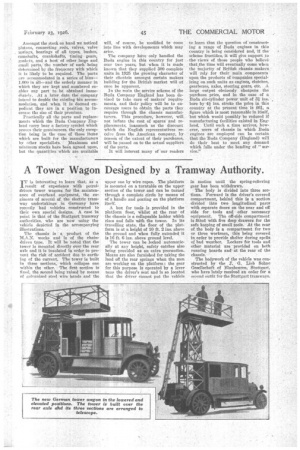A Tower Wagon Designed by a Tramway Authority.
Page 13

If you've noticed an error in this article please click here to report it so we can fix it.
IT is interesting to learn that, as a result of experience with petrol driven tower wagons for the maintenance of overhead equipment, the engineers of several of the electric tramway undertakings in Germany have recently had vehicles constrtteted to their own special designs. A case in point is that of the Stuttgart tramway authorities, who are now using the vehicle depicted in the accompanying illustrations.
The chassis is a product of the M.A.N. works and is of the chaindriven type. It will be noted that the tower is mounted directly over the rear axle and it is insulated in order to prevent the risk of accident due to earthing of the current. The tower is built in three sections, which collapse one within the other. Tlhe first section is fixed, the Second being raised by means of galvanized steel wire bands and the upper one by wire ropes. The platform is mounted on a turntable on the upper section of the tower and can be turned through a complete circle by means of of a handle and gearing on the platform itself..
A lx,x for tools is provided in the platform floor, whilst at the rear of the chassis is a collapsable ladder which rises and falls with the tower. In its travelling state, the floor of the platform is at a height of 10 ft. 2 ins, above the ground and when fully extended it is 16 ft. 6 ins. above ground level.
The tower can be locked automatically at any height, safety catches also being provided as an extra precaution. Means are also furnished for taking the load off the rear springs when the men are working on the platform; the gear for this purpose is operated by a lever near the driver's seat and is so located that the driver cannot put the vehicle in motion until the spring-relieving gear has been withdrawn.
The body is divided into three sections. Forward is the driver's covered compartment, behind this is a section divided into two longitudinal parts with separate doors on the near and off side for tools and other necessary equipment. The •off-side compartment is fitted with five deep drawers for the safe keeping of small tools. At the rear of the body is a compartment for two or three workmen, this being covered in order to provide shelter during spells of bad weather. Lockers for tools and other material are provided on both running boards and at the rear of the chassis.
The bodywork of the vehicle was constructed by the J. G. Lieb Saline Gesellschaft of Blauheuren, Stuttgart, who have lately received an order for a second outfit for the Stuttgart tramways.






























